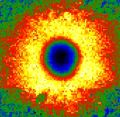Speaker
Description
Casimir self-assembly (CaSA) of micron-sized gold flakes in aqueous solutions at room temperature forms Fabry-Pérot resonators with separation distances of about 100–220 nm and tunable optical responses in the visible spectral range. This study investigates thermal fluctuations, manifested as vertical fluctuations of flakes around their equilibrium position. Using optical microscopy and reflection spectroscopy, we measured deviations in separation distances with 1 nm resolution, mapping the Casimir-electrostatic potential experimentally. Assuming the histogram of separation distances represents a Boltzmann distribution, the interaction potential was reconstructed. Studying ion concentration and flake interaction area revealed changes in potential shape and deviation magnitude. This study confirms the presence of a quantum attractive Casimir force within the cavities and elucidates stability mechanisms and limits of CaSA tunability in surfactant-salt solutions. This platform has great potential for applications in sensors, microfluidics, polaritonic chemistry, nanomachinery, and fundamental quantum effects studies.

